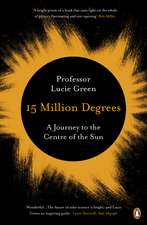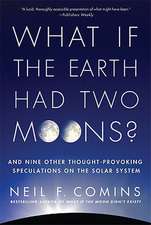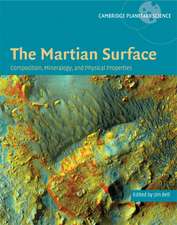The Hatfield SCT Lunar Atlas: Photographic Atlas for Meade, Celestron, and Other SCT Telescopes: A Digitally Re-Mastered Edition
Editat de Anthony Cooken Limba Engleză Paperback – 23 aug 2016
However, the current ranges of Schmidt-Cassegrain and Maksutov telescopes – that’s most of those manufactured by Meade, Celestron, and many others – don’t invert the observed image but instead reverse it left-for-right. That’s with North at the top and East on the left. Because of the way the human visual system works, it is almost impossible to mentally ‘mirror-image’ a map to compare it with the view through the eyepiece , so even turning an IAU-standard atlas upside-down doesn’t help!
This new SCT version of the Atlas solves this problem for observers. Identification of lunar features is made quick and easy.
The new, digitally re-mastered second edition vastly improves the clarity and definition of the original photographs – significantly beyond the resolution limits of the photographic grains present in earlier atlas versions – whilst preserving the layout and style of the original publications. This has been achieved by merging computer-visualized Earth-based views of the lunar surface, derived from NASA’s Lunar Reconnaissance Orbiter data, with scanned copies of Commander Hatfield’s photographic plates, using the author’s own software.
The result is a The Hatfield SCT Lunar Atlas for 21st century amateur telescopes up to and beyond 12-inch aperture.
It contains all the features that made the original so widely used: a combination of an index of all International Astronomical Union named primary lunarfeatures, and twelve chart areas help to locate any named lunar features of interest that can each be examined under typically five different states of illumination. Close ups of interesting features are also included. The new Atlas is supplemented by an introduction to its use, a short description of the digital re-mastering technique, and a completely new section describing lunar observing techniques. At the end of the atlas there is an index of all named features and crater diameters, along with a summary table of the dates and times that the original Hatfield images represent.
Preț: 426.18 lei
Nou
Puncte Express: 639
Preț estimativ în valută:
81.58€ • 88.64$ • 68.57£
81.58€ • 88.64$ • 68.57£
Carte tipărită la comandă
Livrare economică 21 aprilie-05 mai
Preluare comenzi: 021 569.72.76
Specificații
ISBN-13: 9781493938261
ISBN-10: 1493938266
Pagini: 232
Ilustrații: IX, 219 p. 186 illus.
Dimensiuni: 210 x 279 x 12 mm
Greutate: 0.53 kg
Ediția:Softcover reprint of the original 2nd ed. 2014
Editura: Springer
Colecția Springer
Locul publicării:New York, NY, United States
ISBN-10: 1493938266
Pagini: 232
Ilustrații: IX, 219 p. 186 illus.
Dimensiuni: 210 x 279 x 12 mm
Greutate: 0.53 kg
Ediția:Softcover reprint of the original 2nd ed. 2014
Editura: Springer
Colecția Springer
Locul publicării:New York, NY, United States
Cuprins
Publisher's Preface by John Watson.- Introduction.- Plates 1-16 (with charts).- Exposure date chart.- Lunar Observing Techniques.
Recenzii
From the reviews of the second edition:
“There are a plethora of books about lunar observation, this book caters to observers who have a popular Schmidt-Cassegrain telescope (SCT) design or a Maksutov design. … The bulk of the volume provides maps and figures for the moon in 16 sections. … For each area, there are 16 images that show what the features look like when they are illuminated by the sun at different angles. … Summing Up: Recommended. Lower-division undergraduates and general audiences.” (J. R. Kraus, Choice, Vol. 51 (10), June, 2014)
“There are a plethora of books about lunar observation, this book caters to observers who have a popular Schmidt-Cassegrain telescope (SCT) design or a Maksutov design. … The bulk of the volume provides maps and figures for the moon in 16 sections. … For each area, there are 16 images that show what the features look like when they are illuminated by the sun at different angles. … Summing Up: Recommended. Lower-division undergraduates and general audiences.” (J. R. Kraus, Choice, Vol. 51 (10), June, 2014)
Notă biografică
Anthony Charles Cook, Ph.D., FBIS, FRAS, is both an amateur astronomer and a professional lunar and planetary cartographer. He has worked with many leading planetary cartography research groups in the UK, Germany, and the United States. He produced a planet-wide digital elevation model (DEM) of the Moon in the year 2000, and this was used by the European Space Agency to guide its SMART-1 spacecraft down to a precise impact. Six previously unknown impact basins larger than 300 km across were discovered using this lunar DEM. Presently he is a lecturer at the Institute of Mathematics and Physics, Aberystwyth University, in the UK. He is Assistant Director of the British Astronomical Lunar Section and coordinates the Transient Lunar Phenomena observing program alongside a similar program for the Association of Lunar and Planetary Observers. He has also had Digital Planetary Cartography papers published in several refereed scientific journals.
Textul de pe ultima copertă
In a major publishing event for lunar observers, the justly famous Hatfield atlas is updated in even more usable form. This version of Hatfield’s classic atlas solves the problem of mirror images, making identification of left-right reversed imaged lunar features both quick and easy. SCT and Maksutov telescopes – which of course include the best-selling models from Meade and Celestron – reverse the visual image left to right. Thus it is extremely difficult to identify lunar features at the eyepiece of one of the instruments using a conventional Moon atlas, as the human brain does not cope well when trying to compare the real thing with a map that is a mirror image of it. Now this issue has at last been solved.
In this atlas the Moon’s surface is shown at various sun angles, and inset keys show the effects of optical librations. Smaller non-mirrored reference images are also included to make it simple to compare the mirrored SCT plates and maps with those that appear in other atlases. This edition still uses the original photographs taken by Commander Henry Hatfield using his 12-inch reflector, but they have been digitally re-mastered to reveal significantly more lunar surface detail. The key maps, on which lunar features can be readily identified, have been reversed and updated but retain the style and clarity that made the original a standard bearer in the field.
A new chapter on modern lunar observing techniques has been added to show amateur astronomers just how many interesting lunar observing projects they can still participate in. Computer-generated sunrise and sunset visualizations of many interesting selected areas have been included, to encourage astronomers to study and learn about the topographic appearance of the lunar surface near the morning and evening terminators. This welcome second edition brings a trove of new resources while still retainingthe comprehensive appeal of the original.
In this atlas the Moon’s surface is shown at various sun angles, and inset keys show the effects of optical librations. Smaller non-mirrored reference images are also included to make it simple to compare the mirrored SCT plates and maps with those that appear in other atlases. This edition still uses the original photographs taken by Commander Henry Hatfield using his 12-inch reflector, but they have been digitally re-mastered to reveal significantly more lunar surface detail. The key maps, on which lunar features can be readily identified, have been reversed and updated but retain the style and clarity that made the original a standard bearer in the field.
A new chapter on modern lunar observing techniques has been added to show amateur astronomers just how many interesting lunar observing projects they can still participate in. Computer-generated sunrise and sunset visualizations of many interesting selected areas have been included, to encourage astronomers to study and learn about the topographic appearance of the lunar surface near the morning and evening terminators. This welcome second edition brings a trove of new resources while still retainingthe comprehensive appeal of the original.
Caracteristici
Designed specifically for the Schmidt-Cassegrain and Maksutov telescopes (most Meade and Celestron models) A comprehensive lightweight A-Z of the Moon for SCT and Maksutov users Shows different angles of illumination on the lunar surface Includes comparative libration images of the lunar limb This digitally re-mastered edition vastly improves the clarity and definition of the original photographs










